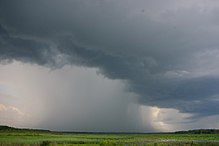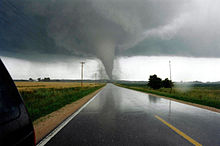Note: Tornadoes are very dangerous and potentially deadly. Always take tornado warnings seriously and immediately seek shelter. |
The Tornadoes Portal

Selected tornado article -
A thunderstorm, also known as an electrical storm or a lightning storm, is a storm characterized by the presence of lightning and its acoustic effect on the Earth's atmosphere, known as thunder. Relatively weak thunderstorms are sometimes called thundershowers. Thunderstorms occur in a type of cloud known as a cumulonimbus. They are usually accompanied by strong winds and often produce heavy rain and sometimes snow, sleet, or hail, but some thunderstorms produce little precipitation or no precipitation at all. Thunderstorms may line up in a series or become a rainband, known as a squall line. Strong or severe thunderstorms include some of the most dangerous weather phenomena, including large hail, strong winds, and tornadoes. Some of the most persistent severe thunderstorms, known as supercells, rotate as do cyclones. While most thunderstorms move with the mean wind flow through the layer of the troposphere that they occupy, vertical wind shear sometimes causes a deviation in their course at a right angle to the wind shear direction.
Thunderstorms result from the rapid upward movement of warm, moist air, sometimes along a front. However, some kind of cloud forcing, whether it is a front, shortwave trough, or another system is needed for the air to rapidly accelerate upward. As the warm, moist air moves upward, it cools, condenses, and forms a cumulonimbus cloud that can reach heights of over 20 kilometres (12 mi). As the rising air reaches its dew point temperature, water vapor condenses into water droplets or ice, reducing pressure locally within the thunderstorm cell. Any precipitation falls the long distance through the clouds towards the Earth's surface. As the droplets fall, they collide with other droplets and become larger. The falling droplets create a downdraft as it pulls cold air with it, and this cold air spreads out at the Earth's surface, occasionally causing strong winds that are commonly associated with thunderstorms. (Full article...)Selected tornado list -

Selected image -

Selected tornado year -
Related portals
2024 tornado activity
Tornado anniversaries
May 5
- 1933 – Strong tornadoes killed 44 people in the Southeastern United States as part of a larger outbreak sequence. A nighttime F4 tornado devastated Helena, Alabama, killing 14 people and leaving most of the survivors homeless. The same tornado killed 7 others near Brent and Colemont. An F3 tornado hit Anderson, Belton, and Barksdale, South Carolina, killing 19 people, most in poorly built homes in Belton. Four others were killed by an F3 tornado in Demopolis, Alabama and near Edna. The roar of the tornado woke many Demopolis residents, likely saving lives.
- 1960 – On the second day of a three-day outbreak sequence, tornadoes killed 32 people across Oklahoma. An F4 tornado or tornado family destroyed a two-block-wide portion of Wilburton, where 13 people died, and killed 3 more in Keota. An F5 tornado killed five people as it swept away homes near Iron Post and devastated the north part of Sapulpa. Another F4 tornado killed five people in one home near Roland.
- 1961 – Part of an outbreak sequence, an F4 tornado caused major damage in Reichert and Howe, Oklahoma, killing 16 people and injuring 58. One other person was killed by an F2 tornado near Dover, Arkansas.
May 6
- 1930 – A tornado outbreak killed at least 81 people across eastern Texas, most of them from two F4 tornadoes. The first destroyed the town of Frost, where at least 22 people died. Another 16 died on farms south of Bynum. At least 41 people were killed overall. The second major tornado killed 36 people, most of them tenant farmers in poorly-built homes near Kenedy, Runge, and Nordheim.
- 1965 – Part of a larger tornado outbreak, four F4 tornadoes impacted the Minneapolis–Saint Paul area, killing 13 people.
May 7
- 1840 – the second-deadliest tornado in U.S. history destroyed the central and northern parts of Natchez, Mississippi and nearby areas, killing at least 317 people. Most of the deaths were in boats on the Mississippi River, which was experiencing high traffic at the time. The death toll may have been much higher, as there were unverified reports that hundreds of slaves were killed in Louisiana. The deaths of slaves in the pre-Civil War United States were not always counted.
- 1846 – A tornado devastated Grenada, Mississippi, killing at least 21 people. There were likely additional deaths later on as people succumbed to their injuries.
Did you know…
- ...that the 2013 Moore tornado that struck Moore and Newcastle, Oklahoma, is the most recent EF5 tornado?
- ...that the 2021 South Moravia tornado, an IF4 tornado with winds between 207–260 mph (333–418 km/h), was the strongest tornado to hit the Czech Republic in modern history?
General images -

Although historically the U.S. state of Connecticut is not typically known to fall casualty to tornadoes, more than 100 of these powerful storms have affected the state in modern history, resulting in at least 48 deaths, 780 injuries, and more than $500 million in damage. This list of tornadoes in the state is likely incomplete, as official records date back only to 1950 for tornadoes in the United States.
As with most of the northeastern United States, the number of tornadoes peaks in the summer months, normally in July or August. Hartford County has had the most tornadoes in the state, although since 1950 Litchfield County has reported the most tornadoes. Several areas have been struck more than once, and Waterbury has been struck by no less than four tornadoes since 1955. (Full article...)List of Featured articles and lists
|
|---|
Topics
Subcategories
Related WikiProjects
The scope of WikiProject Severe weather is to write articles about severe weather, namely thunderstorms and tornadoes. Their talk page is located here.
WikiProject Weather is the main hub for all articles that are weather-related. WikiProject Weather strives to improve articles in a variety of weather topics, including Tropical Cyclones, Severe Weather, General meteorology, Non-tropical Storms, Climate, Floods, Droughts and wildfires, Meteorological instruments and data, Meteorological Biographies, and Space Weather. If you would like to help, please visit the project talk page.
WikiProject Meteorology is a collaborative effort by dozens of Wikipedians to improve the quality of meteorology- and weather-related articles. If you would like to help, visit the project talk page, and see what needs doing. The project is currently being merged into WikiProject Weather.
WikiProject Tropical cyclones is a daughter project of WikiProject meteorology. The dozens of semi-active members and several full-time members focus on improving Wikipedia's coverage of tropical cyclones.
Wikipedia is a fully collaborative effort by volunteers. So if you see something you think you can improve, be bold and get to editing! We appreciate any help you can provide!
Things you can do
Wikimedia
The following Wikimedia Foundation sister projects provide more on this subject:
-
Commons
Free media repository -
Wikibooks
Free textbooks and manuals -
Wikidata
Free knowledge base -
Wikinews
Free-content news -
Wikiquote
Collection of quotations -
Wikisource
Free-content library -
Wikiversity
Free learning tools -
Wikivoyage
Free travel guide -
Wiktionary
Dictionary and thesaurus








































